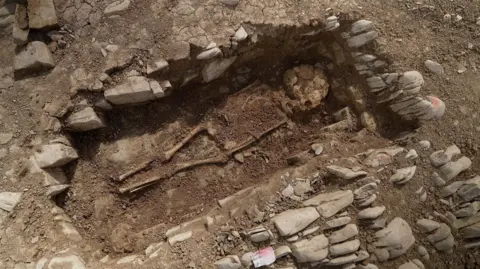Mystery of medieval cemetery near airport runway deepens
 Kevin Church/BBC
Kevin Church/BBCA medieval cemetery unearthed near Cardiff Airport is continuing to confound archaeologists, as the mysteries surrounding it are multiplying.
The discovery of the site, dating to the 6th or 7th Century, was announced last year, with dozens of skeletons found lying in unusual positions with unexpected artefacts.
Now researchers have learned nearly all of those buried in the cemetery are women, and while their bones show signs of wear and tear - indicating they carried out heavy manual work - there are also surprising signs of wealth and luxury.
Another unexpected find has been a woman tossed in a ditch, in stark contrast to all the other people who were buried with great care.
 Kevin Church/BBC
Kevin Church/BBC"Every time we think we understand something, something else crops up and the picture gets more intriguing," said Andy Seaman from Cardiff University, who is leading the project.
About half the site, which lies in an unremarkable field in the grounds of Fonmon Castle, has now been excavated.
So far researchers have found 39 adult skeletons lying in graves carved out of the thick limestone bedrock. A full analysis is still ongoing, but it's thought that all apart from one are female.
"I'm not entirely sure what it means just yet," said Dr Seaman.
"It could be that it's something particular about this community, or it could be that this is perhaps just one cemetery within a broader kind of landscape or it might be that there's more men in another part of the cemetery."
 Kevin Church/BBC
Kevin Church/BBCThe skeletons of two children have also been found - a surprisingly small number given the high infant mortality of the time. Their burials also have some intriguing features.
"The earth that's been used to backfill the grave looks slightly different to that in the adults' graves," explained Dr Marion Shiner, an archaeologist from Cardiff University.
"It's darker and seems more organic, so potentially some time had elapsed between the burial of the adults and the burial of these two children - it's more mystery."
 Kevin Church/BBC
Kevin Church/BBCArtefacts at the site are also adding to the puzzle of who these people were.
Shards of pottery and fine, etched glass unearthed in the graves were most likely brought to the cemetery by people feasting while they visited the dead.
"Glass is rare, and where it is found these are sites of quite significant status," said Dr Seaman.
"It was probably made in the Levant - the Egypt area - and then was manufactured into vessels, we think, in southern France, and probably arrived here alongside wine in barrels."
The presence of these items suggest this was no ordinary community. And each person here has been buried with painstaking care, some laid flat, others crouching, all facing from east to west.
The team don't yet know why the woman flung into the ditch was treated so differently, but believe she could have been an outcast or a criminal.
They have taken her bones to the lab at Cardiff University to try to find out more about her.
Osteologist Dr Katie Faillace says she thinks the woman was in her late 30s or early 40s.
Her skeleton shows a healed fracture to her arm, while her tooth was infected and had an abscess, which exposed the roots and must have been painful.
 Kevin Church/BBC
Kevin Church/BBCTen of the skeletons are also now undergoing more detailed analysis.
The results show the people buried in the cemetery aren't all from the immediate area - they come from all over Wales and possibly from the south-west of England too.
Further DNA analysis will also reveal whether any of them were related.
The team are particularly interested in the skeletons' teeth.
Because of the way teeth grow, they provide a unique record of everything someone has eaten from the time they are weaned right through to their death.
"They've been eating a very consistent diet based on lots of carbs - but not a lot of meat," said Dr Faillace. "And that's true from their childhood into their adulthood, and that's something we're seeing across the population.
"But there was no fish whatsoever. As soon as the Romans leave, we see an absence of fish signals in the diet. It's one of the big mysteries."
 Kevin Church/BBC
Kevin Church/BBCThe dig is continuing this summer and the archaeologists will start to unearth the other half of the cemetery.
Andy Seaman is hoping to be able to answer the questions the site has thrown up.
"We're hoping to tell the story of the individuals within the cemetery, but also the broader community," he said.
"We know a lot about the lives of kings and queens, but much less about everyday people. And never before really have we been able to explore a single community in so much detail and all the interesting inter-relationships."
But for the moment there are still many contradictions that remain unsolved.

Get our flagship newsletter with all the headlines you need to start the day. Sign up here.
